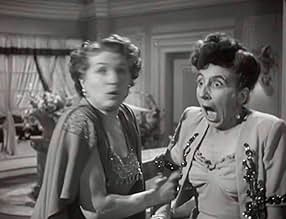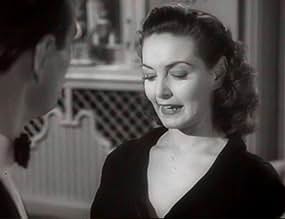Ajouter une intrigue dans votre langueUpper class young man has to resort to employment, together with his valet/butler in tow. He finds a job escourting a robot out for an evening, and they end up in a hotel and a farce ensues ... Tout lireUpper class young man has to resort to employment, together with his valet/butler in tow. He finds a job escourting a robot out for an evening, and they end up in a hotel and a farce ensues when roles are swapped.Upper class young man has to resort to employment, together with his valet/butler in tow. He finds a job escourting a robot out for an evening, and they end up in a hotel and a farce ensues when roles are swapped.
- Réalisation
- Scénario
- Casting principal
- Lady Diana
- (as Anita Bolster)
- Telephonist
- (non crédité)
- Well Dressed Man On Underground
- (non crédité)
Avis à la une
What fascinated me most was the similarities I began to notice with the acting of Leslie Banks as Cavendish with that of the exasperation of Basil Fawlty in "Fawlty Towers" a British TV show by ex-python John Cleese. The tortured expressions and heavily exaggerated body language were the first things to alert me to the "FT" connection. But there was more...
The pace increased exponentially along with the emerging complications of taking a beautiful female robot (impersonated by Malleson's neice) to a honeymoon suite in a posh hotel until the film ended in total chaos.
A foreign servant who spoke very little english and frequently misunderstood his manager's requests (Hmm, Manuel methinks!).
The film was a success when first released, but it is not well-known today, even though it occasionally turns up on television. I note that mine is only the twelfth review it has received. This is probably because it is an adaptation of a farce originally written for the stage. Farce was once a popular genre in the British theatre, but has lost ground in recent decades, and never really transferred well to the screen. For example, "No Sex Please, We're British" was a huge hit in the theatre during the seventies and eighties, but the film version was less successful even at the time, and is virtually unwatchable today, as is "Don't Just Lie There, Say Something!", another seventies film based upon a stage farce. Both those films are based upon the lazy assumption that sex is hilariously funny and that any mention of a sexual topic must therefore be good for a laugh. "The Perfect Woman" is not quite as bad as either of those awful examples, largely because in the forties both the Lord Chamberlain's Office, which governed censorship in the theatre, and its cinematic equivalent, the British Board of Film Censors, took a puritanical view of sexual humour, meaning that comic playwrights and screenwriters had to work harder for their laughs.
I can imagine that a film like this came across as quite funny in 1949. The lovely Patricia Roc makes Penelope a spirited heroine. I assumed that Roc was also playing Olga the Robot, but in fact that role went to an otherwise little-known actress named Pamela Devis, cast on the basis of her physical resemblance. (With modern computer trickery it would today be quite easy to have the same actress playing two different characters in the same scene, but perhaps this would not have been possible in the forties). Nigel Patrick and Stanley Holloway, however, seem to be trying too hard as Cavendish and Ramshead; Holloway in particular came across as too frenetic, which disappointed me as I have admired some of his other performances such as those he gave in "Passport to Pimlico" (also from 1949) and "My Fair Lady". The main problem with the film, however, is that its style of humour seems just too old-fashioned for the tastes of modern audiences. 5/10.
This is a set-up for a farce that the movies have been using at least since Lubitsch's DIE PUPPE.. Like many a post-war British sex farce, it seems a bit sniggering and brittle, but the cast is perfect. Not only was Malleson born to play woolly-brained old men, but there's Irene Handl as a maid-of-all-work called "Buttercup" and David Hurst as a Swiss prototype for Manuel in FAWLTEY TOWERS.
It really was amazing how quickly two people could fall in love back in 1949 - That was the only note I took down whilst watching this film and sadly, because it was a bit forgettable, I can't really think what else to write about it in this review.
I know that it wasn't offensive and that there was a charm to it and an element of fun, but I don't think that I could really say much about the general construction of the film.
The only characters I can recall were the professor who invented the "Perfect Woman" and who was cute in his own way, but quite typical of inventors in film and also Stanley Holloway's butler, a man who knew his place, but didn't stay there.
I'm sure that they all gave perfectly adequate performances, because otherwise I would have made a note of it and I know that Irene Handl usually delivers a great character, but perhaps there have just been too many of this type of film that meant it didn't leave a specific mark.
The actual robot needing instructions to move or do anything, was a bit silly, like the daft scene in 'Mrs Doubtfire' (1993), where Robin Williams had to keep changing personas over dinner and that was a tired humour even in 1949 as far as I'm concerned.
So while it wasn't a bad film, it really didn't make any kind of impression on me and I wouldn't bother with it again.
380.61/1000.
Movies based on plays often translate poorly to celluloid and perhaps that's the issue here.
The story and dialogue contain odd little holes and the humour sometimes seems places. Not quite forced but certainly not flowing from the story or situation directly.
The acting is good, especially from Patricia Roc and (the entirely silent) Pamela Devis.
The real credit I can give this movie is that I still really enjoyed it. If someone put the original play on, even AmDram, I'm pretty sure I'd be getting tickets!
Le saviez-vous
- AnecdotesPamela Devis's debut.
- Citations
Mrs. Butters: You and your Mars and your Jupiter. Why don't you come down to Earth for a change?
Meilleurs choix
Détails
- Durée
- 1h 29min(89 min)
- Couleur
- Rapport de forme
- 1.37 : 1
































